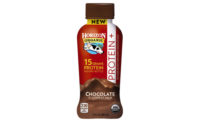Milk's Inherent Prebiotic: Lactose
The nutrient profile of milk might be denser than previously believed thanks to ongoing research suggesting that milk’s carbohydrate - lactose - possesses beneficial health and wellness properties.
 The nutrient profile of milk might be denser than previously believed thanks to ongoing research suggesting that milk’s carbohydrate - lactose - possesses beneficial health and wellness properties.
The nutrient profile of milk might be denser than previously believed thanks to ongoing research suggesting that milk’s carbohydrate - lactose - possesses beneficial health and wellness properties.
“Lactose, also known as milk sugar, is different than most other sugars, as it is a ‘slow food,’” according to Joe O’Donnell, executive director, California Dairy Research Foundation, Davis, Calif. “This has profound implications compared to the fast sugars. When the fast sugars are absorbed quickly, there is not enough energy demand to use them all at once so they are converted to fat. Lactose, being slow absorbed, paces itself to the body’s energy needs.
“This is true even with infants,” he adds. “Yes, some baby fat must come from lactose but that kind of fat, which is described as peripheral, is much healthier than the abdominal fat linked to diabetes.”
Completing the package
Many of us in the dairy industry talk about how milk is the whole package. It is a complete protein, containing all of the essential amino acids in the proportion that the body uses most efficiently. The fat component includes conjugated linoleic acid, which assists with weight management by decreasing total body fat and increasing lean muscle mass. Milk is also an inherently good source of potassium, a great source of phosphorus and an incredible source of calcium.
But what is special about lactose, besides the fact that many individuals claim they cannot properly digest this sugar that possesses only about 20% of the sweetness of sucrose? There must be some logical reason why lactose is only found in milk, a baby’s first food.
According to a paper written by Andrew Szilagyi, MD, a professor with the McGill University School of Medicine, The Sir Mortimer B, Davis-Jewish General Hospital, Montreal, Quebec, and published in the Canadian Journal of Gastroenterology (March 2004), lactose is maldigested by up to 75% of the world’s population. “When many of these people consume lactose, they suffer symptoms reminiscent of irritable bowel syndrome, thus, most research to date has concentrated on ways of improving lactose tolerance to enhance dairy as a source of nutrition,” he writes. “Research on other possible benefits of lactose and its maldigestion has lagged.”
In view of an exponential growth in the understanding of intestinal microfloral host interactions and the expanding therapeutic potential of probiotics, Szilagyi examined scientific and clinical knowledge about the properties of lactose. He concludes that in lactase non-persistent subjects, lactose qualifies as a prebiotic.
O’Donnell concurs, explaining that many nutrition authorities believe that lactose should qualify as fiber. Why? “Because in most adults, not all of the lactose consumed via dairy foods is digested,” he says. “Thus, the lactose goes to the colon and feeds the bacteria that have the enzymes to break it down - usually good bacteria, those described as probiotics. One can overdo this mechanism, leading to the gastrointestinal distress associated with too much lactose. This varies by individual and the other components of the meal. The point is, only milk contains lactose, and this is nature’s strategy to keep good microbial ecology in the colon.”
Interestingly, according to Sheldon Baker, senior partner with Baker Dillon Group, a Fresno, Calif.-based brand marketing firm, “Prebiotics were first identified in the mid-‘90s, but little has been done outside the supplement industry to promote awareness to the masses. I believe that U.S. consumers do not understand the concept of prebiotics, or even know they exist.”
But we in the dairy foods formulating world not only know they exist, but are most likely already adding them to formulations, or planning to add them in the near future. Most marketing departments prefer to tout the inclusion of prebiotic fiber food ingredients such as inulin, oligofructose, polydextrose and resistant maltodextrin as simply ingredients that boost fiber content rather than saying they stimulate the growth of intestinal bacteria.
The good news is that it appears that milk, all on its own, does that, without the addition of other ingredients. Hopefully future clinical research will confirm that the carbohydrates in milk play a significant role in digestive and intestinal health throughout the life cycle. n
Donna Berry is the product development editor for Dairy Foods. She can be reached at 773-463-2467 or donnaberry@dairy-food.com.

“Lactose, also known as milk sugar, is different than most other sugars, as it is a ‘slow food,’” according to Joe O’Donnell, executive director, California Dairy Research Foundation, Davis, Calif. “This has profound implications compared to the fast sugars. When the fast sugars are absorbed quickly, there is not enough energy demand to use them all at once so they are converted to fat. Lactose, being slow absorbed, paces itself to the body’s energy needs.
“This is true even with infants,” he adds. “Yes, some baby fat must come from lactose but that kind of fat, which is described as peripheral, is much healthier than the abdominal fat linked to diabetes.”
Completing the package
Many of us in the dairy industry talk about how milk is the whole package. It is a complete protein, containing all of the essential amino acids in the proportion that the body uses most efficiently. The fat component includes conjugated linoleic acid, which assists with weight management by decreasing total body fat and increasing lean muscle mass. Milk is also an inherently good source of potassium, a great source of phosphorus and an incredible source of calcium.
But what is special about lactose, besides the fact that many individuals claim they cannot properly digest this sugar that possesses only about 20% of the sweetness of sucrose? There must be some logical reason why lactose is only found in milk, a baby’s first food.
According to a paper written by Andrew Szilagyi, MD, a professor with the McGill University School of Medicine, The Sir Mortimer B, Davis-Jewish General Hospital, Montreal, Quebec, and published in the Canadian Journal of Gastroenterology (March 2004), lactose is maldigested by up to 75% of the world’s population. “When many of these people consume lactose, they suffer symptoms reminiscent of irritable bowel syndrome, thus, most research to date has concentrated on ways of improving lactose tolerance to enhance dairy as a source of nutrition,” he writes. “Research on other possible benefits of lactose and its maldigestion has lagged.”
In view of an exponential growth in the understanding of intestinal microfloral host interactions and the expanding therapeutic potential of probiotics, Szilagyi examined scientific and clinical knowledge about the properties of lactose. He concludes that in lactase non-persistent subjects, lactose qualifies as a prebiotic.
O’Donnell concurs, explaining that many nutrition authorities believe that lactose should qualify as fiber. Why? “Because in most adults, not all of the lactose consumed via dairy foods is digested,” he says. “Thus, the lactose goes to the colon and feeds the bacteria that have the enzymes to break it down - usually good bacteria, those described as probiotics. One can overdo this mechanism, leading to the gastrointestinal distress associated with too much lactose. This varies by individual and the other components of the meal. The point is, only milk contains lactose, and this is nature’s strategy to keep good microbial ecology in the colon.”
Interestingly, according to Sheldon Baker, senior partner with Baker Dillon Group, a Fresno, Calif.-based brand marketing firm, “Prebiotics were first identified in the mid-‘90s, but little has been done outside the supplement industry to promote awareness to the masses. I believe that U.S. consumers do not understand the concept of prebiotics, or even know they exist.”
But we in the dairy foods formulating world not only know they exist, but are most likely already adding them to formulations, or planning to add them in the near future. Most marketing departments prefer to tout the inclusion of prebiotic fiber food ingredients such as inulin, oligofructose, polydextrose and resistant maltodextrin as simply ingredients that boost fiber content rather than saying they stimulate the growth of intestinal bacteria.
The good news is that it appears that milk, all on its own, does that, without the addition of other ingredients. Hopefully future clinical research will confirm that the carbohydrates in milk play a significant role in digestive and intestinal health throughout the life cycle. n
Donna Berry is the product development editor for Dairy Foods. She can be reached at 773-463-2467 or donnaberry@dairy-food.com.
Looking for a reprint of this article?
From high-res PDFs to custom plaques, order your copy today!





